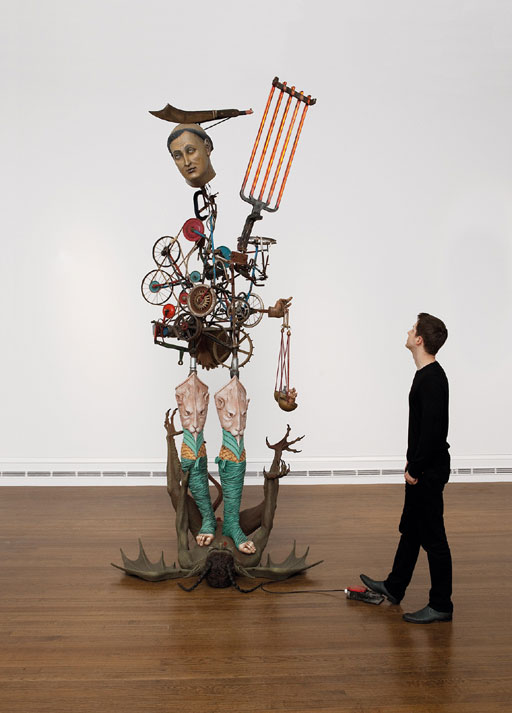 Half the saints were broken. No one knew quite why, when they would be fixed, or even by whom. On hearing the news, some drifted out of line. The majority kept their places, marching ahead in slow procession, believing a solution would be found before it was their appointed time to enter.
Half the saints were broken. No one knew quite why, when they would be fixed, or even by whom. On hearing the news, some drifted out of line. The majority kept their places, marching ahead in slow procession, believing a solution would be found before it was their appointed time to enter.
When functioning, Michael Landy’s gargantuan, kinetic sculptures of saints groan and creak as they perform their miserable tasks of self-mortification. At the push of a button, they beat, slice, and otherwise mutilate themselves for about ten seconds before grinding to a halt, awaiting the next visitor. With their rummaged parts visibly straining to perform their weighty tasks, the saints reveal themselves not as otherworldly exemplars but rather faulty human fabrications. They do not intervene to save us, it is we who bring them to life. And only briefly.
This allegory of shaken, incapacitated faith is even more pronounced when Landy’s mechanisms misfire. While visitors wait for the saints to stir, museum security guards enthusiastically explain their function, like priests reporting the miraculous properties of dubious relics. In these moments, the saints appear to be nothing more than naked monuments of futility; rusty myths incapable of resurrection.
So are Landy’s sculptures cynical statements of disbelief from an artist who grew up Catholic? At times he seems to deflect the question, finding other ways in which the saints might speak to him. He finds an amusing similarity, for instance, between the self-flagellations of the hermit Saint Jerome and his own studio practice, where he retreats into his “cave” to beat himself up. Ultimately, he confesses, “I’m not a non-believer or a believer. I’m a ‘don’t know’.”
The genius of Landy’s contraptions lies in this deep ambivalence. They won’t convert the unbeliever or rattle the believer. But, working or not, they expose something of the mechanisms of faith: the staggering leap of imagination needed to believe in the deeds and powers of long-dead martyrs, and to re-enter the encompassing religious reality from which their stories spring.
The leap is clearly tempting for Landy. In 2001, in his immensely popular installation Break Down (2001), the artist systematically catalogued and destroyed all of his earthly possessions as audiences watched, literally leaving him with only the clothes on his back. This radical disavowal of property enacted within a world – particularly an art world – besotted with consumption has become an almost hagiographical feature of the artist’s biography. At the time, some critics compared his performance to St Francis’s rejection of his family fortune for a life of privation, a story Landy knew from childhood.
In Saints Alive, Landy explicitly returns to the devotions of St Francis, albeit with a cheeky twist. A mechanical claw dips into a giant, headless sculpture of the saint and fishes out T-shirts for the audience, each emblazoned with the Franciscan vows of poverty, chastity and obedience. To some, this may look like simple mockery. But there is a profound and sensitive truth here. If the saints really are alive today, they must learn to work their miracles amidst the ironic, commercial and mundane. Whether they succeed or not, Landy gives them a chance.
Michael Landy: Saints Alive is at the National Gallery, London, until 24 November

